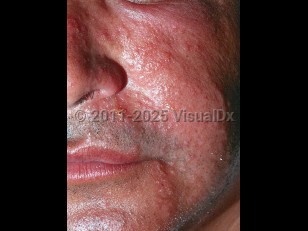Sea cucumber skin irritation
Alerts and Notices
Important News & Links
Synopsis

Sea cucumbers are worm-like echinoderms (other echinoderms are sea urchins and starfish) found on the sea floor in tropical, subtropical, and temperate waters. They have elongated bodies, leathery skin with warty bumps or soft spines, tentacles that surround their mouth, and tube feet with suction cups running along the body.
Some sea cucumbers, when disturbed or irritated, can expel sticky internal organs called Cuvierian tubules from the anus as a defense mechanism to immobilize predators; they then re-grow new tubules. Another mechanism of defense is expulsion of a jet of toxin-containing liquid from the anus. The most important toxin is holothurin-A, which is a water-soluble and heat-stable glycoside. Contact with the toxin causes a local inflammatory reaction and can cause severe conjunctival and corneal irritation. Ocular damage or blindness can occur if not treated properly. Some sea cucumbers eat stinging cells (nematocysts) and may secrete the coelenterate venom.
Sea cucumbers are slow moving and non-aggressive, so injury occurs after deliberate contact.
Some sea cucumbers, when disturbed or irritated, can expel sticky internal organs called Cuvierian tubules from the anus as a defense mechanism to immobilize predators; they then re-grow new tubules. Another mechanism of defense is expulsion of a jet of toxin-containing liquid from the anus. The most important toxin is holothurin-A, which is a water-soluble and heat-stable glycoside. Contact with the toxin causes a local inflammatory reaction and can cause severe conjunctival and corneal irritation. Ocular damage or blindness can occur if not treated properly. Some sea cucumbers eat stinging cells (nematocysts) and may secrete the coelenterate venom.
Sea cucumbers are slow moving and non-aggressive, so injury occurs after deliberate contact.
Codes
ICD10CM:
T63.691A – Toxic effect of contact with other venomous marine animals, accidental, initial encounter
SNOMEDCT:
241837001 – Poisoning by sea cucumber
T63.691A – Toxic effect of contact with other venomous marine animals, accidental, initial encounter
SNOMEDCT:
241837001 – Poisoning by sea cucumber
Look For
Subscription Required
Diagnostic Pearls
Subscription Required
Differential Diagnosis & Pitfalls

To perform a comparison, select diagnoses from the classic differential
Subscription Required
Best Tests
Subscription Required
Management Pearls
Subscription Required
Therapy
Subscription Required
References
Subscription Required
Last Updated:10/19/2017
Sea cucumber skin irritation

